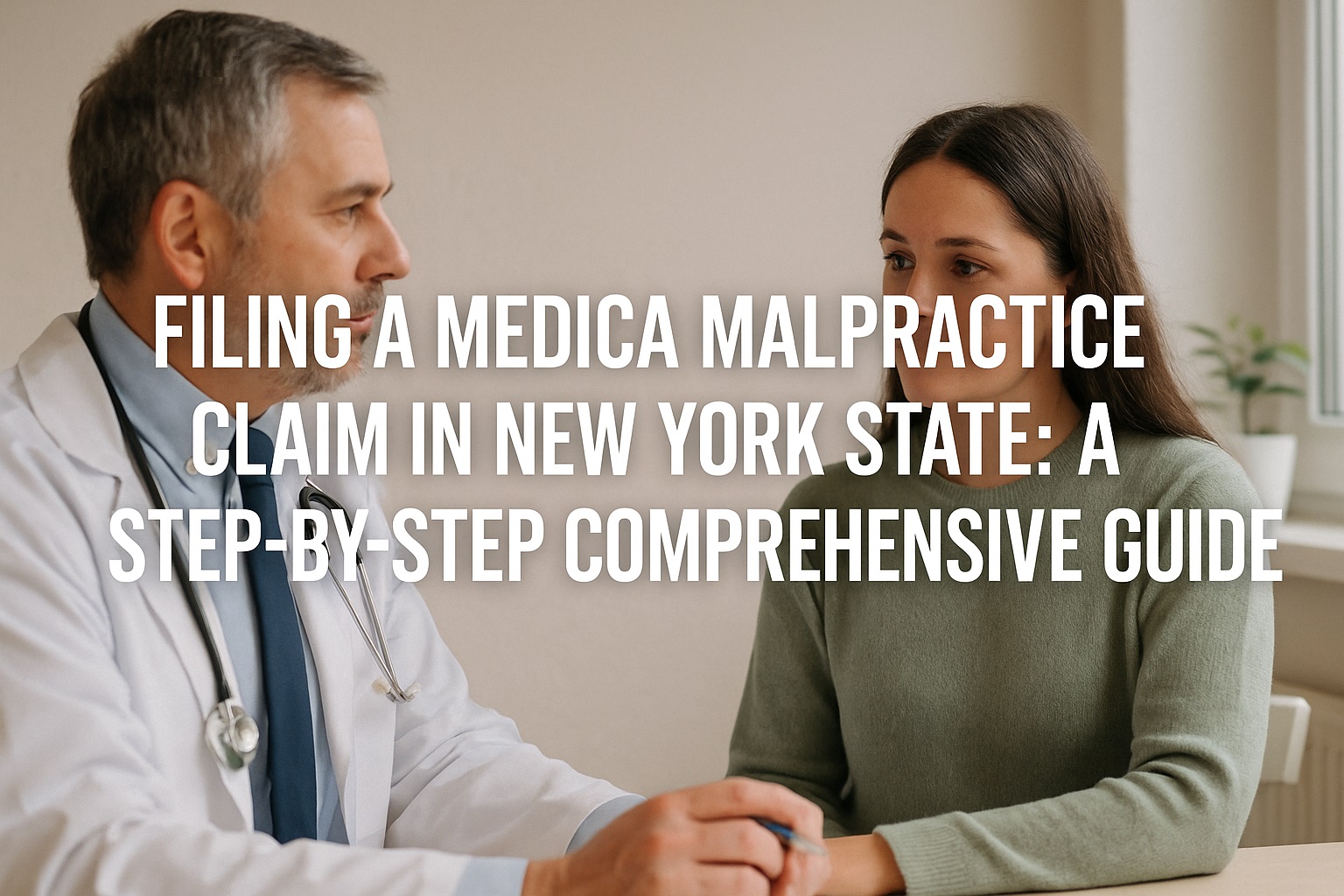Medical malpractice cases represent some of the most emotionally and financially taxing disputes in the legal system. When a healthcare professional’s negligence or deviation from accepted standards of care causes injury or death, the victim—already grappling with physical pain, psychological trauma, and mounting medical bills—must navigate complex statutory procedures, stringent deadlines, and robust legal defenses by hospitals and insurers. In New York State, the intricacies of medical malpractice law are governed by unique rules such as the 90-day pre-action notice requirement (CPLR § 3024-a), the Certificate of Merit, and caps on non-economic damages under the Hospital Indemnity Act (CPLR § 5102-b). This exhaustive guide will walk you through every phase of filing a medical malpractice claim, from selecting experts to statutory notices, discovery, trial preparation, settlement negotiation, and post-trial appeals. Each section is designed with detailed explanations, practical tips, and illustrative examples to ensure that both victims and their advocates can pursue justice effectively and efficiently.
- Understanding Medical Malpractice Law in New York
Medical malpractice occurs when a healthcare provider, such as a physician, surgeon, nurse, or hospital, fails to meet the applicable standard of care, resulting in patient harm. In New York, the legal foundation rests on tort principles: duty, breach, causation, and damages. Every licensed practitioner owes patients a duty to exercise the same degree of skill, care, and diligence commonly possessed and exercised by a reasonably competent professional in that field. Breach of this duty may arise from errors in diagnosis, surgical mistakes, medication errors, birth injuries, or failure to obtain informed consent. However, proving breach and causation requires expert testimony demonstrating that the provider’s conduct fell outside the accepted standard and that this deviation was a proximate cause of the injury. New York courts apply a rigorous analysis: they scrutinize medical records, deposition transcripts, and credible expert reports. Familiarizing yourself with landmark cases—such as Echevarria v. Cole and Bruni v. Tatsumi—provides insight into how New York’s judiciary interprets the standard of care and compensable harm. In addition, understanding statutory amendments like the Hospital Indemnity Act’s non-economic damage caps and the distinct treatment of punitive damages is essential for realistic case valuation and client counseling.
- Pre-Action Requirements: Notices of Claim and Certificates of Merit
Before a plaintiff can formally commence a medical malpractice lawsuit in New York, two critical pre-action requirements must be satisfied. First, under CPLR § 3024-a, the claimant must serve a Notice of Claim on every prospective defendant within 90 days after the alleged malpractice is discovered or should have been discovered, but no later than two and a half years from the act or omission. This notice must include a detailed factual statement of the alleged malpractice, specifying the time, place, and manner in which the negligence occurred, allowing providers to investigate promptly. Second, under CPLR § 3012-a, the plaintiff must file a Certificate of Merit with the summons and complaint, attesting that a qualified medical expert has reviewed the case and affirmed that there is reasonable basis to initiate the action. The expert’s curriculum vitae must accompany the certificate, detailing the expert’s qualifications, training, and license status. Failure to comply with either requirement is fatal: courts have dismissed actions for noncompliance with strict enforcement, even when plaintiffs later cure or attempt to supplement deficient notices. Therefore, meticulous drafting and timely service of notices and certificates protect the case from procedural dismissal and preserve the plaintiff’s substantive rights.
- Selecting and Working with Medical Experts
Medical experts represent the cornerstone of any malpractice claim, providing the bedrock testimony on the standard of care and causation. In New York, experts must hold valid licenses in the same or substantially similar specialty as the defendant at the time of the alleged malpractice. Strategic expert selection involves vetting potential witnesses for both credentials and trial experience: ideal candidates possess academic publications, hospital affiliations, and a history of courtroom testimony. Once retained, draft detailed expert engagement letters outlining the scope of review, deadlines for report submission, and fee arrangements—whether hourly, flat, or contingent. Promptly provide experts with redacted medical records, imaging studies, operative notes, and deposition transcripts of treating providers. Work with experts to prepare comprehensive reports including a clear explanation of how the deviation from standard care occurred, the timeline of negligent events, the mechanism of injury, and any factors affecting damages (e.g., preexisting conditions). Regular status conferences help ensure timely report finalization and alignment with court schedules. During depositions, prepare experts to withstand Daubert/Mahler challenges by reinforcing their methodological rigor and familiarity with peer-reviewed literature. Effective collaboration with medical experts greatly strengthens your position in settlement negotiations and at trial.
- Drafting the Complaint and Pleadings
After completing pre-action formalities and expert review, drafting a precise and persuasive complaint is essential. The complaint must include detailed factual allegations: identify each defendant (physician, hospital, laboratory), specify dates and locations of treatment, chart sequences of negligent acts or omissions, and itemize injuries and damages. Avoid boilerplate language; instead, tailor allegations to the case facts, highlighting egregious conduct such as retention of foreign objects, wrong-site surgery, or misinterpretation of diagnostic tests. Include causes of action for negligence, gross negligence (if applicable), lack of informed consent, battery (for unauthorized procedures), and Loss of Consortium for spouses of injured patients. Attach the Certificate of Merit and ensure all named parties have been timely served. After service, defendants will typically respond with an answer and may assert affirmative defenses—statute of limitations, comparative negligence, immunities, or failure to mitigate. Anticipate these defenses by gathering records showing prompt filing, patient adherence to treatment protocols, and mitigation efforts. Thoughtful pleading not only frames your case narrative but sets the stage for discovery battles and summary judgment motions.
- Discovery: Uncovering Evidence and Deposing Witnesses
Discovery in medical malpractice actions is expansive, encompassing written demands and document requests under CPLR §§ 3101 and 3120, as well as depositions of parties, experts, and fact witnesses. Effectively using discovery tools can uncover critical evidence and weaken opposing positions. Serve early demands for production of all medical records—including internal hospital quality assurance reports, peer review committee minutes (subject to confidentiality debates), and risk management documents. Demand physician continuing education records, hospital credentialing files, and internal communications regarding the incident. Concurrently, prepare a robust deposition strategy: depose the treating providers to probe inconsistencies in their records, confront them with contradictory statements, and test their recollection of standard procedures. Depose hospital administrators about staffing levels, safety protocols, and any known equipment malfunctions. Use electronic discovery methods to trace email communications and metadata for timeline reconstruction. Motions to compel or for protective orders may arise; be ready to litigate document privilege claims and ensure that privileged information is preserved in privilege logs. Discovery often reveals case strengths and weaknesses, informs settlement strategy, and provides surprises that can be game-changers at trial.
- Settlement Negotiations and Alternative Dispute Resolution
Given the high costs and risks of trial, most malpractice cases resolve through settlement. Effective negotiation combines thorough case assessment with timing and leverage. Develop a demand letter summarizing your client’s injuries, medical prognosis, economic and non-economic losses, and a proposed settlement figure. Support demands with demonstrative exhibits—medical animations showing injury mechanisms, itemized medical bills, wage-loss calculations, and expert reports. Employers often use mediation or early neutral evaluation (ENE) to facilitate resolution; prepare by selecting a neutral evaluator versed in medical malpractice, exchanging position statements, and disclosing key evidence. In mediation, be candid but firm: convey your willingness to proceed to trial if a reasonable offer isn’t made. Encourage defendants to understand their exposure—including punitive damages and reputational harm for hospitals. If settlement stalls, explore structured settlements or periodic payment agreements, especially when large verdicts exceed hospital indemnity caps. Clear communication with clients about realistic outcomes, insurer policies, and potential appellate risks ensures informed decision-making throughout the settlement process.
- Trial Preparation: Jury Selection, Opening Statements, and Evidence Presentation
Trials in medical malpractice demand exhaustive preparation. Start jury selection months in advance by crafting voir dire questions that identify biases—opinions on doctors, insurance companies, or lawsuits generally. Develop juror profiles to seat an impartial jury likely to empathize with your case narrative. Prepare an opening statement that weaves a human story: introduce your client, outline the timeline of care, illustrate the moment negligence occurred, and preview key evidence. Use simple, jargon-free language and visual aids such as timelines or anatomical diagrams. For evidence presentation, organize exhibits chronologically and label them clearly on binders for the court. Coordinate with courtroom technology staff to present radiology images, videos of depositions, and demonstrative models. Direct and cross-examinations should be planned meticulously: script key questions, anticipate defense witness strategies, and rehearse responses to hostile questioning. Plan to introduce expert testimony through deposition excerpts if live testimony is impractical, following CPLR § 3117. Throughout trial, maintain a flexible strategy that adapts to judicial rulings on evidence admissibility and unforeseen witness behavior.
- Verdict, Post-Trial Motions, and Appeals
After closing arguments, the jury deliberates on liability and damages. Upon a plaintiff’s verdict, immediately prepare post-trial motions: CPLR § 4401 motions to set aside verdicts for errors exceeding the evidence or jury misconduct, and motions to vacate where judge-made errors affected the trial’s fairness. If the verdict is unsatisfactory, file a notice of appeal within 30 days under CPLR § 5515. Appellate briefing requires pinpoint citations to trial records, articulation of preserved errors, and persuasive legal arguments based on New York precedents. While appeals can be lengthy, successful appellate decisions may secure new trials or appellate reduction of damages. In some cases, defendants may also appeal, triggering cross-appeals and further appellate strategy. Throughout post-trial proceedings, ensure compliance with filing deadlines and appellate court rules to protect your client’s rights and maximize recovery.
- Navigating Damage Caps and Structured Settlements in New York
New York’s Hospital Indemnity Act caps non-economic damages in malpractice actions against hospitals at $250,000, except increased amounts in limited circumstances. Noneconomic damages—pain and suffering, emotional distress, loss of enjoyment of life—often represent the largest portion of recovery. Attorneys must carefully calculate the cap implications when negotiating settlements or projecting trial awards. Moreover, structured settlements can address liquidity concerns for clients awarded large lump sums: annuities guarantee periodic payments, tax benefits, and protection from irresponsible spending. Selecting trustworthy settlement planners involves due diligence to find reputable providers and negotiates favorable terms. Additionally, explore collateral source rule exceptions: although New York often deducts paid medical bills from damage awards, prudent drafting of settlement documents can minimize offsets, preserving client net recovery. Understanding these financial mechanics ensures clients receive full value from their malpractice victories.
- Pro Bono and Contingent Fee Considerations
Given the prohibitive expense of medical experts and litigation, many malpractice attorneys work on a contingent fee basis, advancing costs and deferring payment until recovery. Typical contingencies range from 30% to 40% of net recovery, subject to court approval. Document fee agreements transparently and comply with New York Rules of Professional Conduct § 1.5. For clients lacking insurance coverage, pro bono representation by legal aid foundations and specialized pro bono panels at the New York State Trial Lawyers Association can fill the gap. These programs match clients with volunteer attorneys and offer access to expert networks willing to work on reduced-fee or pro bono arrangements. Navigating financial hurdles at intake—through client counseling on anticipated costs, funding strategies, and possible retention of expense financing services—improves case viability and reduces client anxiety.
Conclusion
Pursuing a medical malpractice claim in New York State is a complex, resource-intensive endeavor demanding meticulous adherence to statutory requirements, expert collaboration, and strategic courtroom advocacy. From the initial 90-day notice and Certificate of Merit to trial preparation, verdict challenges, and appellate review, each phase presents unique challenges and opportunities. By leveraging the detailed guidance in this step-by-step manual—whether you are a plaintiff, defense attorney, or legal advocate—you can navigate New York’s stringent malpractice laws with confidence, protect clients’ rights, and achieve just compensation for devastating medical injuries.








